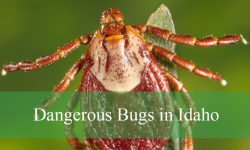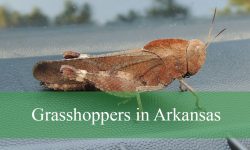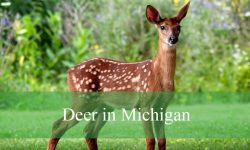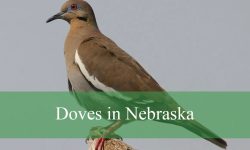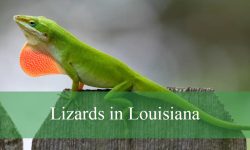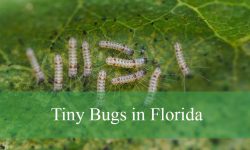If you enjoy exploring Georgia’s natural landscapes, you’ll quickly notice the rhythmic tapping and calls of woodpeckers echoing through the trees. These birds are active, colorful, and essential to forest health, shaping ecosystems by creating nesting sites and controlling insect populations.
Georgia’s diverse environments—from pine savannas to hardwood forests—provide perfect homes for many species. Some, like the Downy and Red-bellied Woodpeckers, adapt easily to backyards, while others such as the Red-cockaded Woodpecker thrive only in mature pine stands.
Each species has its own charm, from the brilliant red head of the Red-headed Woodpecker to the powerful drumming of the Pileated. This guide introduces nine species found in Georgia, offering identification tips, habitats, and insights into their behavior.
Types of Woodpeckers Found in Georgia
Downy Woodpecker (Dryobates pubescens)
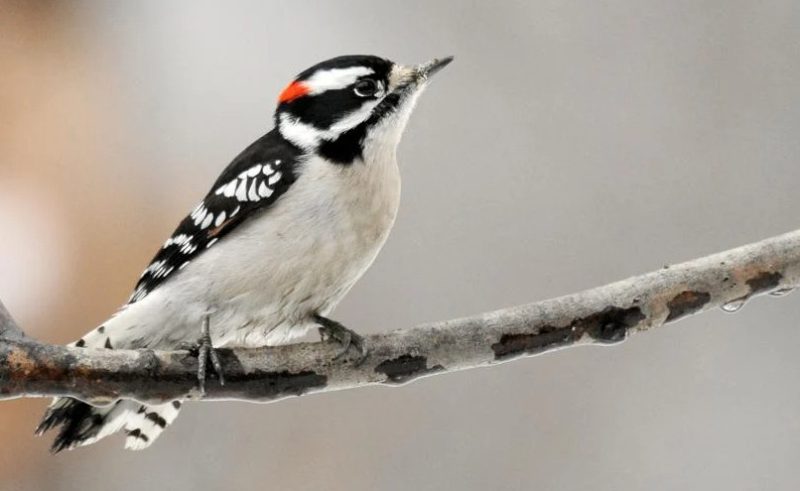
The Downy Woodpecker is the smallest and most widespread woodpecker in Georgia. Measuring about 6 to 7 inches long, it features a short bill, black wings with white spots, and a white underside. Males have a small red patch on the back of the head, while females lack this marking. Despite its size, the Downy Woodpecker is an energetic bird often seen clinging to tree trunks and branches as it searches for insects.
This species is easily identified by its distinctive “pik” call and drumming sounds on hollow branches. Its short, stubby bill makes it well-suited for pecking at smaller twigs rather than thick trunks. The Downy can sometimes be mistaken for the Hairy Woodpecker, but it’s noticeably smaller and has proportionally shorter bills.
In Georgia, Downy Woodpeckers are common year-round residents. They inhabit a wide range of habitats, including deciduous forests, suburban parks, orchards, and backyard feeders. They are frequent visitors to suet feeders, especially in winter when insects are scarce.
Their adaptable nature allows them to thrive in both rural and urban settings. They nest in small cavities they excavate themselves in softwood trees, usually laying four to five eggs. The species plays a vital role in controlling insect populations, particularly wood-boring beetles and larvae.
Hairy Woodpecker (Dryobates villosus)
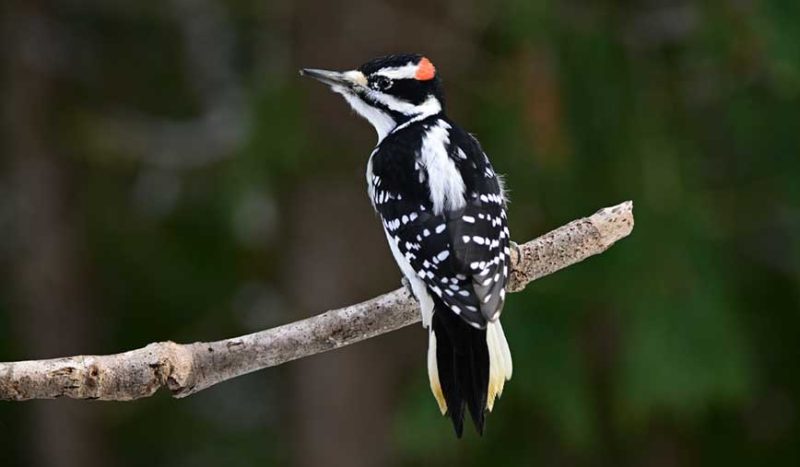
The Hairy Woodpecker is slightly larger than its Downy relative, measuring around 9 to 10 inches in length. It shares similar black-and-white plumage but has a noticeably longer, chisel-like bill. Males have a red patch at the back of the head, while females do not. Its sleek, contrasting pattern and strong build make it one of the most striking medium-sized woodpeckers in Georgia.
This species’ loud, sharp “peek” call and more forceful drumming distinguish it from the smaller Downy Woodpecker. Hairy Woodpeckers are strong excavators, often creating deep holes in the bark while searching for beetle larvae and carpenter ants. Their foraging is methodical and deliberate, often on mature trees and dead snags.
In Georgia, Hairy Woodpeckers are permanent residents throughout the year. They are more commonly found in mature forests, wooded riverbanks, and large parks with old-growth trees. Unlike the Downy, they are less frequent in suburban areas, preferring natural woodlands with thicker tree cover.
Hairy Woodpeckers excavate nesting cavities high in dead trees or branches, often reusing the same sites each season. Their presence is a sign of healthy woodland ecosystems, as they depend on decaying trees for nesting and feeding. They play a crucial ecological role in controlling insect infestations that can damage forest trees.
Red-bellied Woodpecker (Melanerpes carolinus)
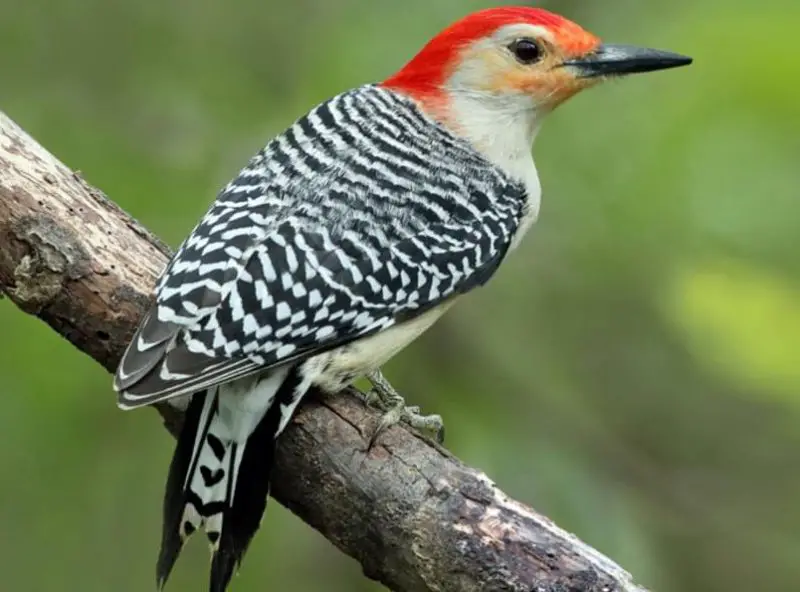
The Red-bellied Woodpecker is one of the most familiar and colorful woodpeckers in Georgia. Despite its name, the red on its belly is faint and often hard to see. More prominent is the bright red cap that covers the head of males and the nape of females. Their black-and-white barred backs and pale faces make them easy to recognize.
These birds are medium-sized, measuring about 9 to 10.5 inches in length, with a wingspan of around 13 to 16 inches. Their loud, rolling “churr” call is a common sound in wooded neighborhoods and forests alike. Red-bellied Woodpeckers are agile climbers, often storing acorns and insects in tree crevices during fall for later use.
They thrive across Georgia’s forests, woodlots, and suburban yards, where they frequently visit suet and peanut feeders. This species is a year-round resident, equally comfortable in rural pine stands and city parks. In winter, they are especially active around feeders and dead trees rich in insect activity.
Their nesting season begins in spring when pairs excavate cavities in dead trees or utility poles. Both parents share incubation and feeding duties. As opportunistic omnivores, they feed on insects, nuts, seeds, and fruit, contributing to forest regeneration through seed dispersal.
Northern Flicker (Colaptes auratus)
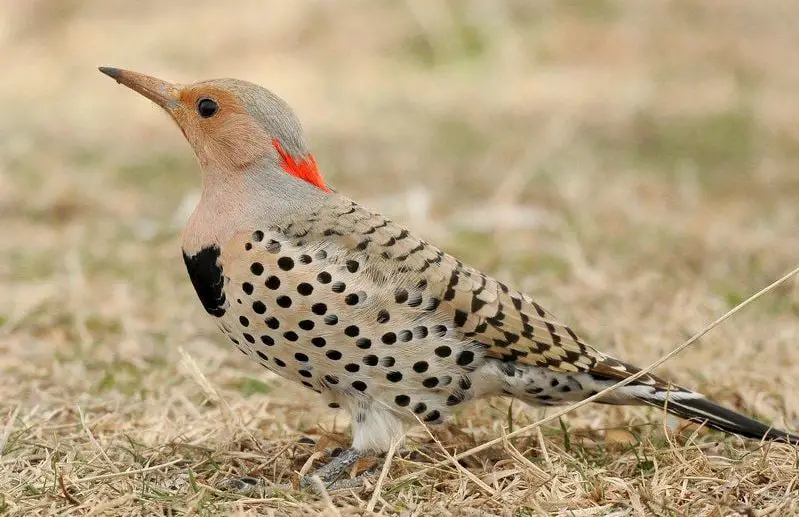
The Northern Flicker stands out among Georgia’s woodpeckers for its unique brown and spotted plumage. Unlike most woodpeckers, it spends much of its time on the ground, searching for ants—its primary food source. It has a sleek body about 11 to 12 inches long, a rounded head, and a slightly curved bill. Males have a black “mustache” stripe on the face, while females do not.
Its wings and back are patterned with black bars, while the belly shows black polka dots. The underside of the wings and tail glows yellow in flight in the eastern subspecies known as the “Yellow-shafted Flicker.” Its loud “wicka-wicka” call is often heard echoing through open woodlands and forest edges.
In Georgia, Northern Flickers are common throughout the year, especially in open woodlands, parks, and fields with scattered trees. They prefer areas with soft ground where ants and beetles are abundant. During migration seasons, flickers can be seen in larger numbers as northern populations move through the state.
They nest in cavities excavated in dead or decaying trees and sometimes reuse holes created by other woodpeckers. Their unusual ground-foraging behavior and striking coloration make them one of the most easily recognized woodpeckers in the state. They play an important role in controlling ant populations in various ecosystems.
Pileated Woodpecker (Dryocopus pileatus)
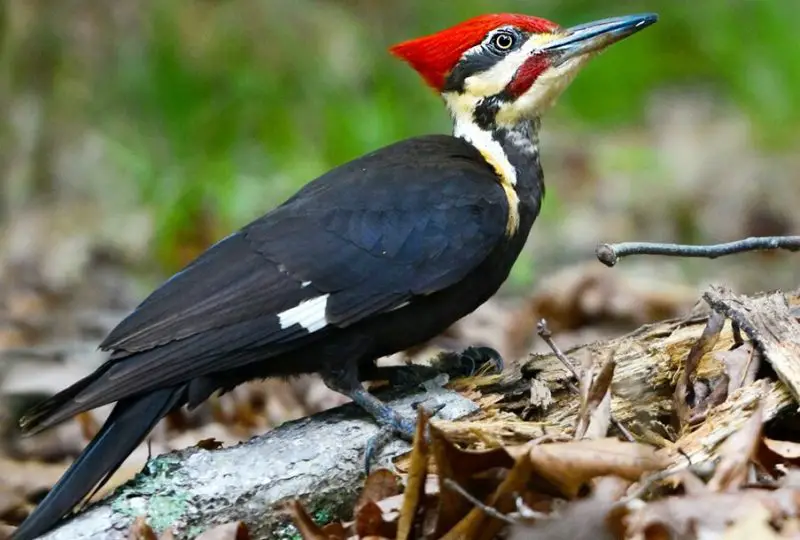
The Pileated Woodpecker is Georgia’s largest and most dramatic woodpecker, often described as the inspiration for the cartoon character Woody Woodpecker. Reaching up to 19 inches long with a wingspan of nearly 30 inches, this striking bird features a bold red crest, black body, and white stripes running down its neck. Its powerful bill can excavate large rectangular holes in trees while searching for carpenter ants.
Pileated Woodpeckers are unmistakable due to their loud, echoing “kuk-kuk-kuk” calls and deep drumming that resonates through forests. They prefer mature forests with large trees, especially near rivers or wetlands. Their strong claws and stiff tail feathers help them cling to vertical trunks as they forage for insects.
In Georgia, Pileated Woodpeckers are year-round residents found statewide. They thrive in extensive hardwood and mixed pine forests, though they occasionally venture into wooded suburbs. Spotting one is a thrilling experience due to their size and dramatic flight, which features deep, slow wingbeats.
They excavate large nesting cavities used not only by themselves but later by owls, bats, and other wildlife, making them ecosystem engineers. Their feeding habits help control ant and beetle populations, while their nesting activity creates essential habitat for other species. The Pileated Woodpecker is a true icon of Georgia’s wild forests.
Red-headed Woodpecker (Melanerpes erythrocephalus)
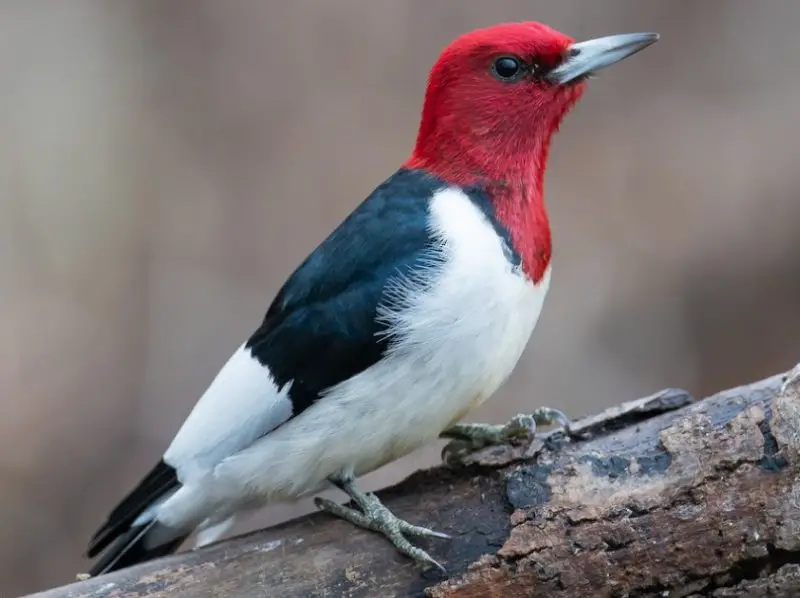
The Red-headed Woodpecker is one of Georgia’s most striking birds, instantly recognizable by its entirely red head, neck, and throat. Its glossy black back and wings contrast sharply with pure white underparts and wing patches, creating a bold, eye-catching appearance. Adults measure about 8 to 9 inches long, and both sexes look identical—a rarity among woodpeckers.
This species is known for its acrobatic behavior and diverse feeding habits. It catches insects in midair, gleans them from tree bark, and even stores nuts and seeds in tree crevices for future use. Red-headed Woodpeckers are also known to cover stored food with bark or wood chips, a behavior unique among North American woodpeckers.
In Georgia, they are most common in open woodlands, farmlands, and pine savannas, especially in the southern and central regions. They favor habitats with scattered trees and dead snags for nesting and foraging. Although present year-round, their populations fluctuate seasonally, as some individuals migrate south in winter.
Red-headed Woodpeckers nest in tree cavities, often using dead or decaying trees near open areas. Both parents share incubation and feeding duties. Sadly, habitat loss and competition for nesting sites have led to declines in their population. Conservation efforts in Georgia’s managed forests help maintain suitable environments for this brilliant and energetic bird.
Yellow-bellied Sapsucker (Sphyrapicus varius)
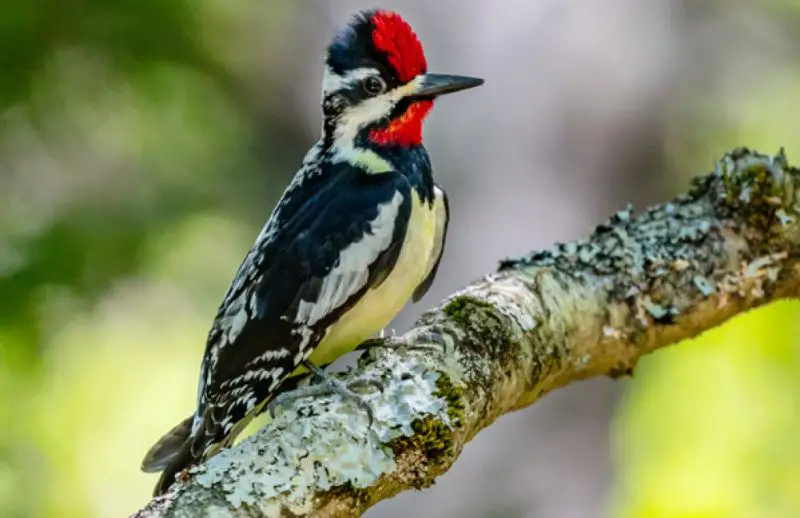
The Yellow-bellied Sapsucker is a small, migratory woodpecker found in Georgia mainly during the winter months. It measures about 7 to 8.5 inches long and has a distinctive patterned plumage of black and white, with a red forehead and crown. The faint yellow wash on its belly gives the bird its name, though it’s often hard to notice unless seen up close.
This species is unique among Georgia’s woodpeckers for its feeding method. It drills small, neatly spaced holes—known as sap wells—into tree bark to feed on the sap and the insects attracted to it. Maple, birch, and hickory trees are among its favorites. The sapsucker returns regularly to maintain these wells and defend them from other birds.
In Georgia, Yellow-bellied Sapsuckers appear primarily from late October through early April. They prefer mixed forests, orchards, and wooded suburbs where they can find sap-producing trees. During migration, they can be spotted across the state, especially in deciduous forests and parks.
Their presence can sometimes cause minor tree damage, but they play a valuable ecological role by helping other species access sap and insects. In breeding season, they migrate northward to the Appalachian Mountains and beyond. While not a permanent resident, the Yellow-bellied Sapsucker is a welcome winter visitor to Georgia’s woodlands.
Red-cockaded Woodpecker (Dryobates borealis)
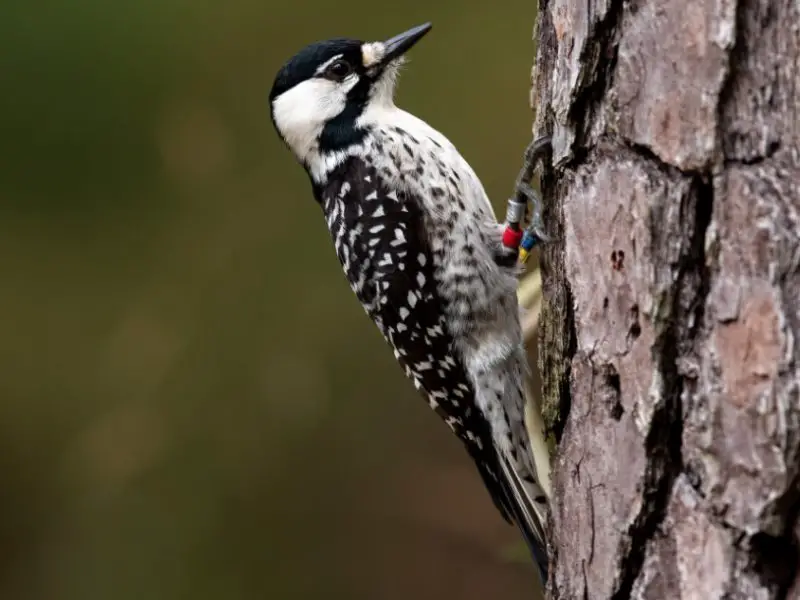
The Red-cockaded Woodpecker is one of Georgia’s most significant and endangered bird species. It is a small black-and-white woodpecker about 8 to 9 inches long, with a distinctive pattern of white cheek patches. Males have a tiny red streak—or “cockade”—behind the eye, though it is often difficult to see. Its appearance is otherwise less flashy than other species, but its ecological importance is immense.
This species is unique for its strong dependence on mature pine forests, particularly longleaf pines. It excavates nesting and roosting cavities in living pine trees softened by heart rot, a process that may take months or years. Red-cockaded Woodpeckers live in cooperative family groups, with offspring from previous years helping their parents care for new young.
In Georgia, these birds are primarily found in the Coastal Plain and parts of the Piedmont where mature pine ecosystems persist. Places such as Fort Stewart, Okefenokee National Wildlife Refuge, and the Oconee National Forest host stable populations. Conservation and prescribed burning are crucial to maintaining the open pine habitat they require.
Listed as a federally endangered species, the Red-cockaded Woodpecker symbolizes successful conservation collaboration. Habitat management programs across Georgia have helped stabilize their numbers, but continued protection of mature pine forests remains vital to their survival.
Lewis’s Woodpecker (Melanerpes lewis)
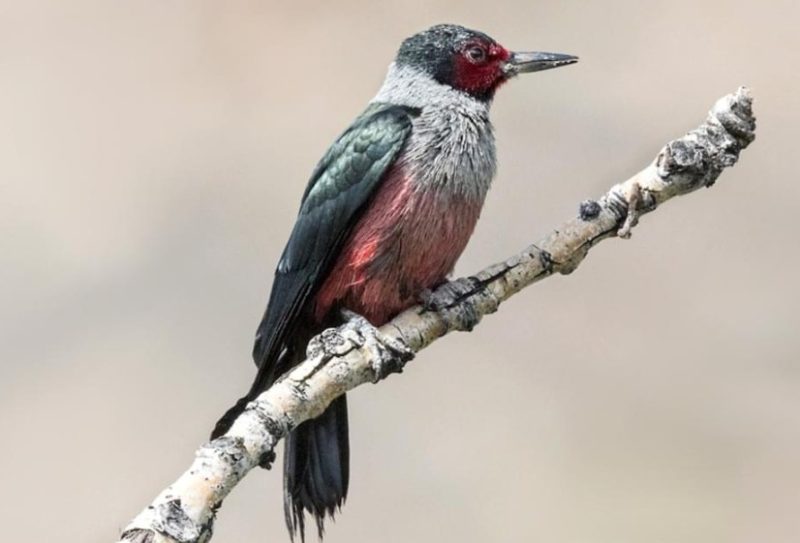
Lewis’s Woodpecker is a rare and irregular visitor to Georgia, usually seen only during migration or when birds wander far from their typical western range. Named after explorer Meriwether Lewis, this medium-sized woodpecker is unlike any other species found in the state. It has a dark greenish-black back, pinkish belly, gray collar, and a red face patch—making it one of North America’s most beautiful woodpeckers.
This species stands out not just for its colors but also for its behavior. Unlike most woodpeckers, Lewis’s often catches insects in midair, using graceful flight patterns similar to flycatchers. It also feeds on nuts, berries, and acorns, storing them in tree crevices for winter. Its quiet nature and gentle flight make it easy to overlook unless observed closely.
In Georgia, Lewis’s Woodpecker sightings are extremely uncommon and typically occur during unusual winter irruptions or storms that push individuals eastward. When they do appear, they are most likely to be found in open woodlands, dead pine groves, or near rivers with standing snags.
While it’s not part of Georgia’s regular avifauna, its occasional presence adds excitement for birdwatchers. Spotting a Lewis’s Woodpecker in Georgia is considered a rare event and a highlight for any birding enthusiast lucky enough to witness it.
Tips for Watching Woodpeckers in Georgia
Choose the Right Habitat
Woodpeckers in Georgia thrive in diverse habitats ranging from dense pine forests to open woodlands and suburban parks. To spot the greatest variety, visit mature forests with old or dead trees, as these provide ideal nesting and foraging sites. State parks like Oconee National Forest, Okefenokee National Wildlife Refuge, and Fort Yargo State Park are excellent places to start your search.
Go Birding Early in the Morning
The best time to observe woodpeckers is early morning, when they are most active and vocal. During these hours, their drumming and calls are easier to hear, helping you locate them from a distance. A quiet walk at sunrise through wooded areas often yields the best sightings.
Bring Binoculars and Listen Carefully
Since many woodpeckers stay high in the canopy, a good pair of binoculars is essential. Listen for distinct tapping or drumming sounds on trees, which often lead directly to a bird. The rhythmic drumming of species like the Pileated or Hairy Woodpecker can be heard from far away and serves as an excellent cue.
Set Up Backyard Feeders
Attracting woodpeckers to your yard is easy with suet feeders, peanuts, or black oil sunflower seeds. Downy and Red-bellied Woodpeckers are frequent backyard visitors, especially in winter. Place feeders near trees or wooden poles to give them a natural landing spot.
Respect Their Space
When birdwatching, maintain a respectful distance—especially during breeding season. Avoid disturbing nesting trees or using playback calls excessively. Woodpeckers are sensitive to habitat disruption, so ethical birding ensures their continued presence and natural behavior.
FAQs About Woodpeckers in Georgia
What is the most common woodpecker in Georgia?
The Red-bellied Woodpecker is the most common and widespread species in Georgia. It adapts well to both forests and suburban environments and can be seen year-round across the state.
Are there any endangered woodpeckers in Georgia?
Yes. The Red-cockaded Woodpecker (Dryobates borealis) is federally listed as endangered. It depends on mature pine ecosystems, particularly longleaf pine forests, which have been reduced by habitat loss. Conservation programs are actively restoring these habitats.
What is the largest woodpecker in Georgia?
The Pileated Woodpecker (Dryocopus pileatus) is the largest woodpecker in Georgia and one of the biggest in North America. It can reach nearly 19 inches in length and has a loud, resonant call that echoes through the forest.
Do woodpeckers migrate in Georgia?
Most Georgia woodpeckers are year-round residents, including the Downy, Hairy, and Red-bellied species. However, the Yellow-bellied Sapsucker is a migratory visitor, typically arriving in fall and leaving by early spring.
Where can I see the Red-cockaded Woodpecker in Georgia?
Your best chances are in protected pine habitats such as Fort Stewart, Okefenokee National Wildlife Refuge, Reed Bingham State Park, and the Oconee National Forest. These areas support managed longleaf pine ecosystems crucial for this endangered species.
Why do woodpeckers peck on houses or poles?
Woodpeckers may drum on metal poles, siding, or wood to communicate, attract mates, or establish territory. This behavior usually peaks in spring. Providing alternative drumming surfaces, like dead branches or wooden posts, can reduce this problem.
Can I attract woodpeckers to my backyard?
Absolutely! Offer suet cakes, peanuts, and mealworms, and provide natural trees or logs for perching and nesting. Avoid using pesticides so their insect food sources remain abundant. Patience pays off—Downy and Red-bellied Woodpeckers are among the first to appear.
What time of year is best for woodpecker watching in Georgia?
While woodpeckers can be seen year-round, late winter through spring is the best time. During this period, they are highly active, vocal, and easy to spot while establishing territories and excavating nesting cavities.

